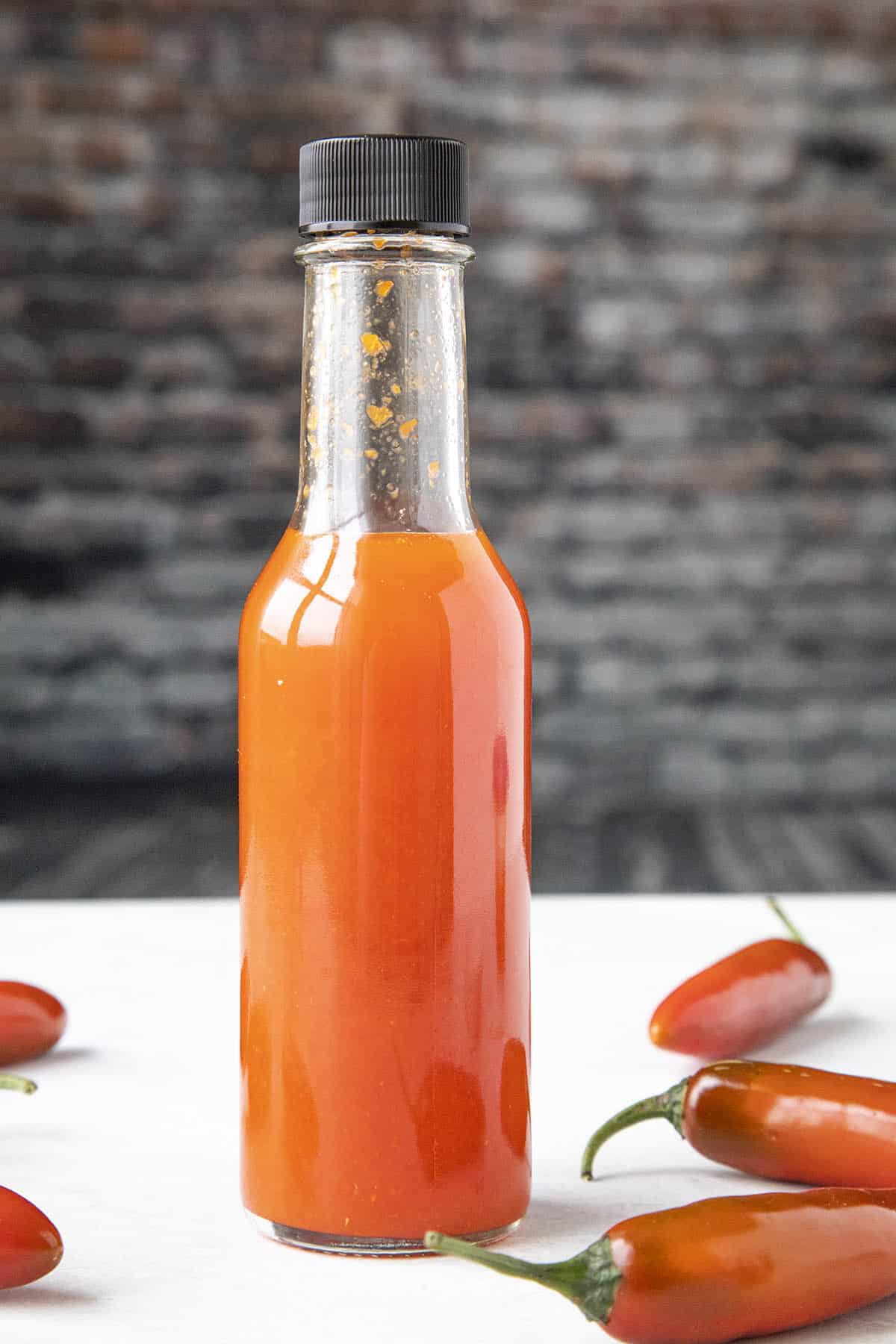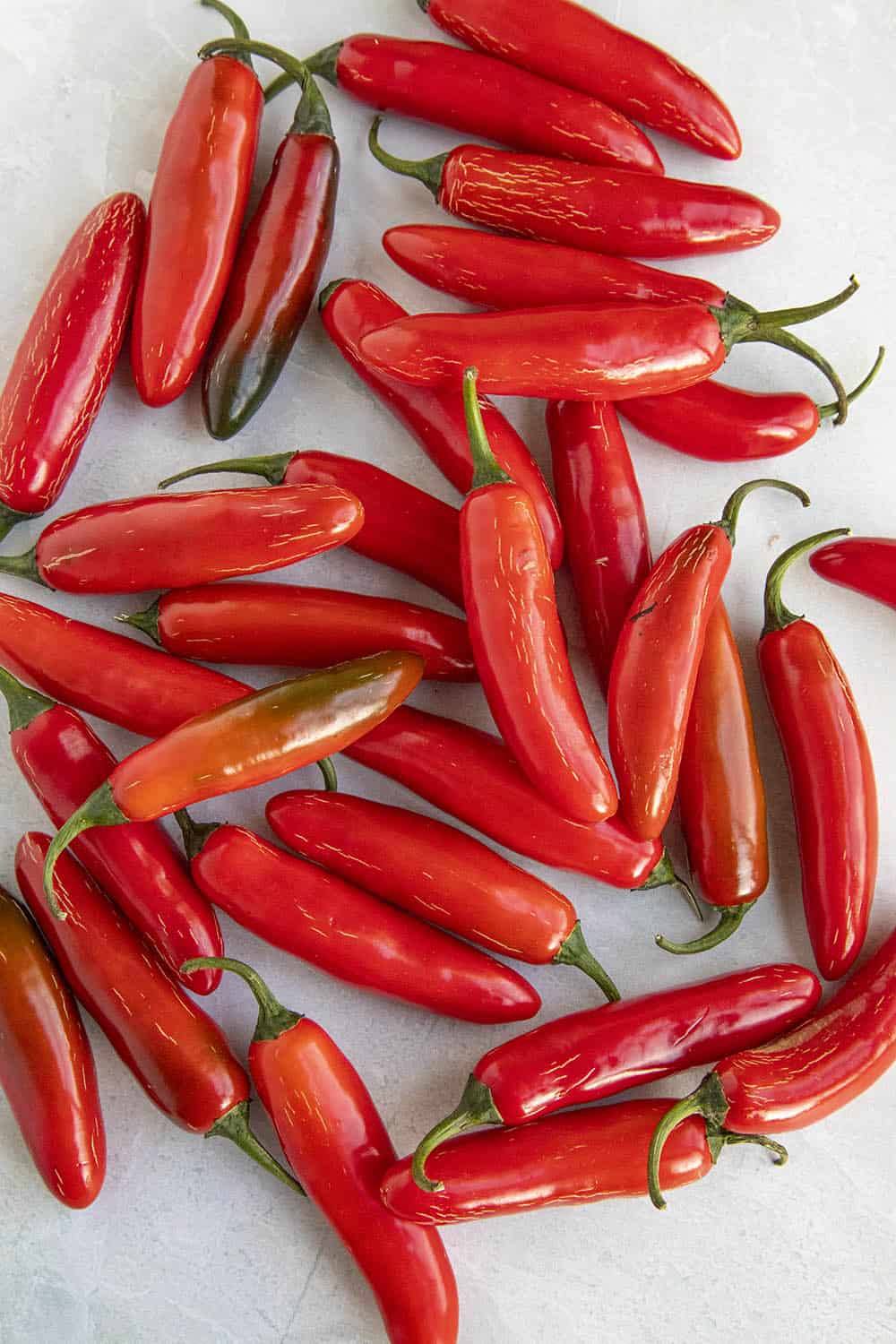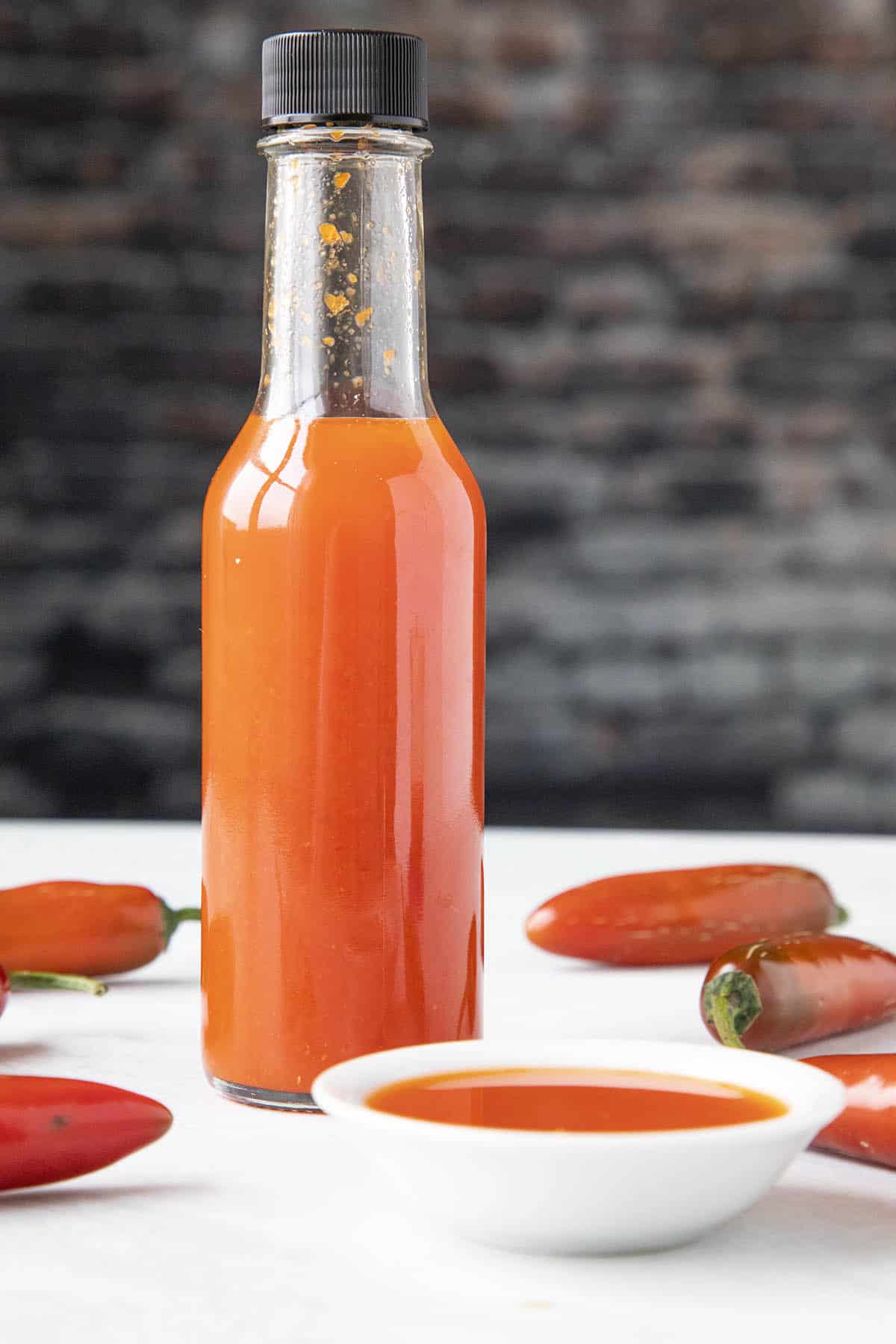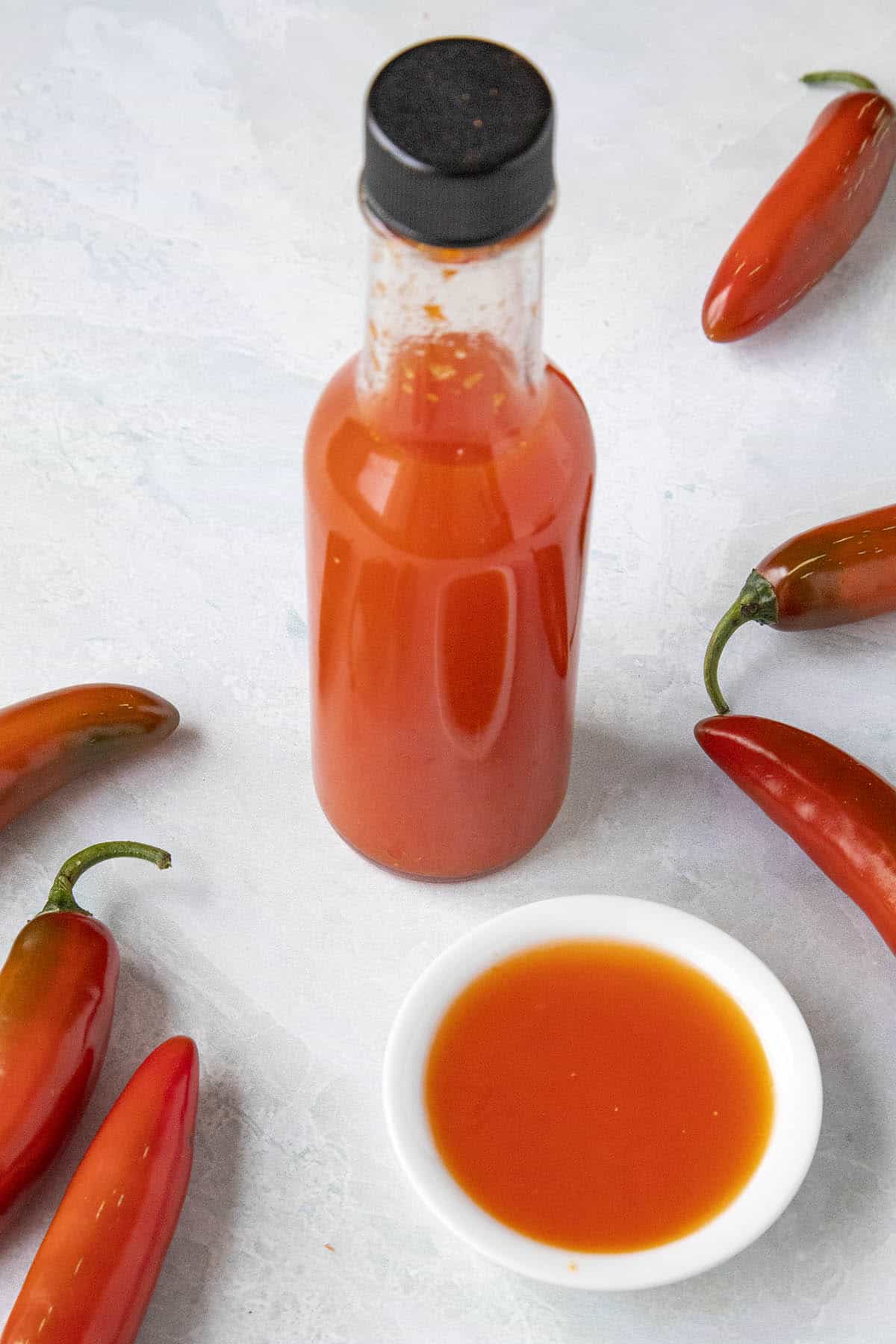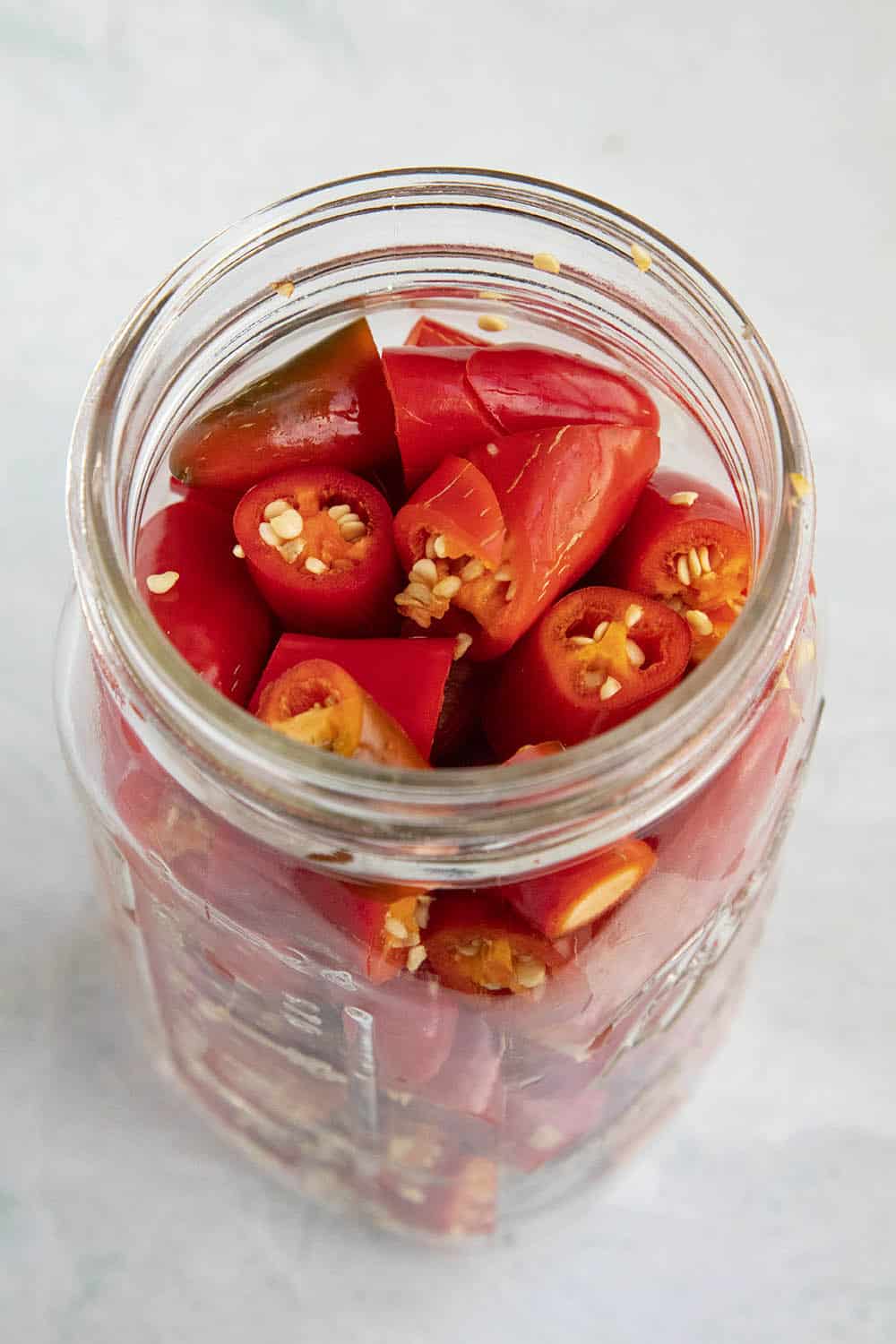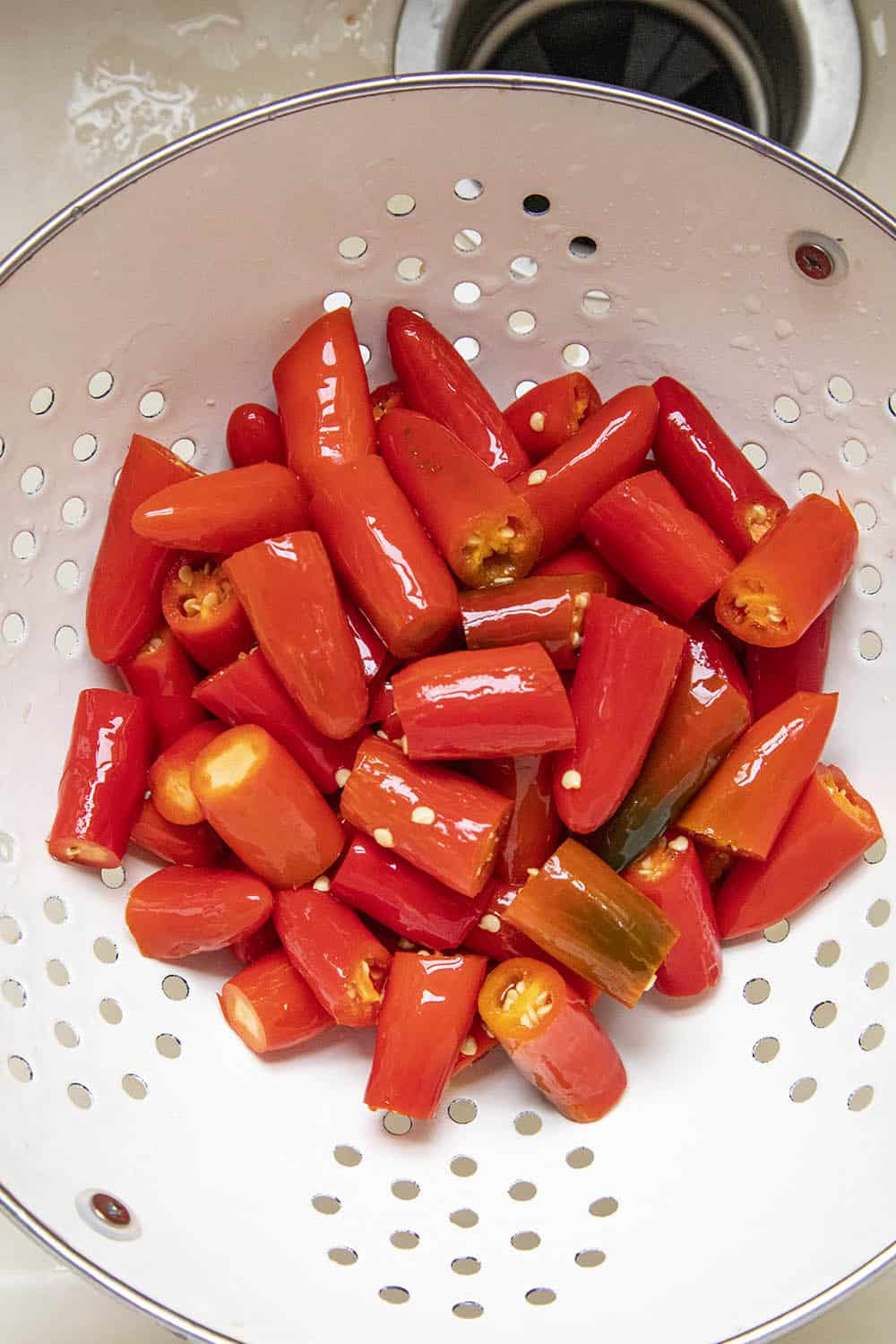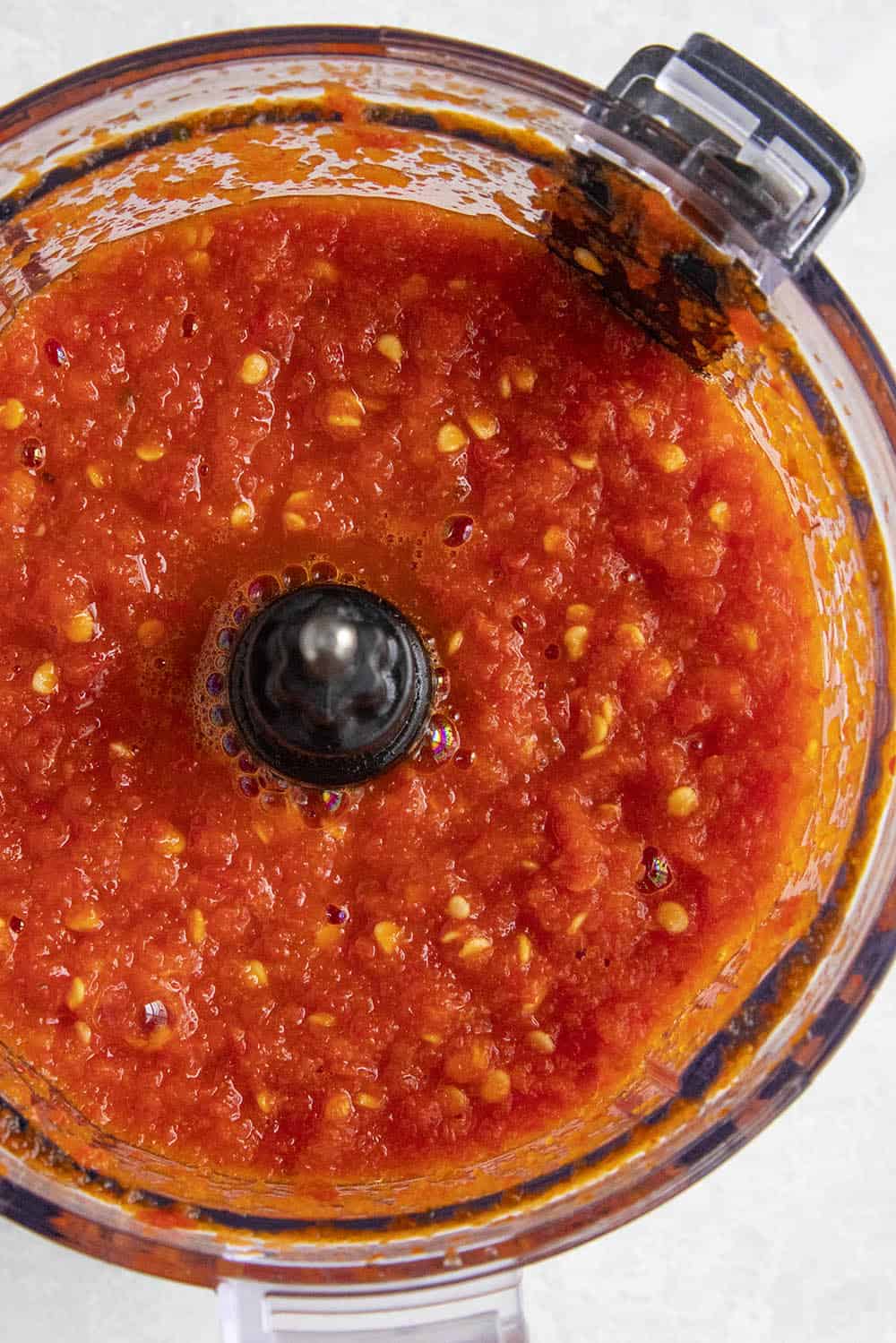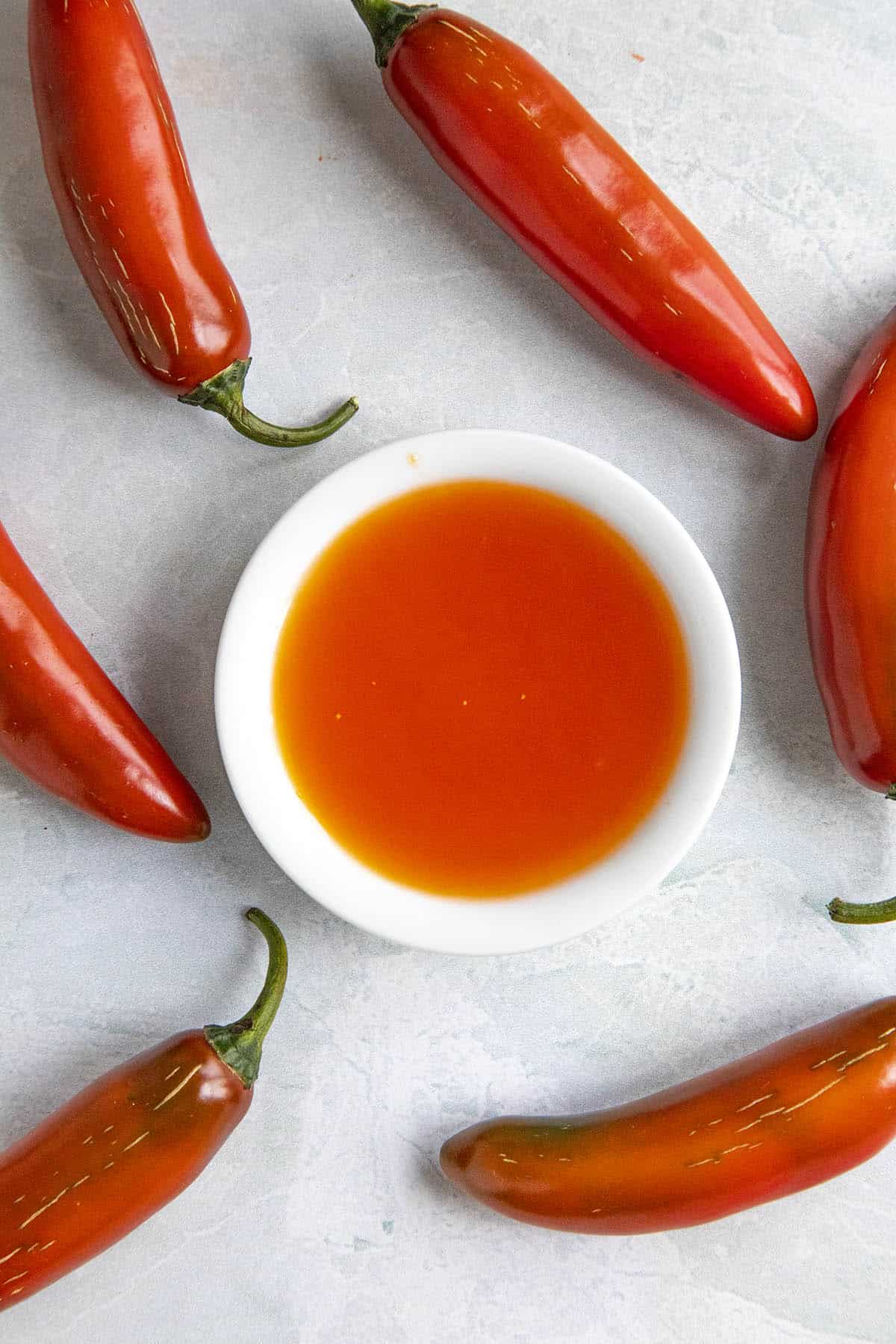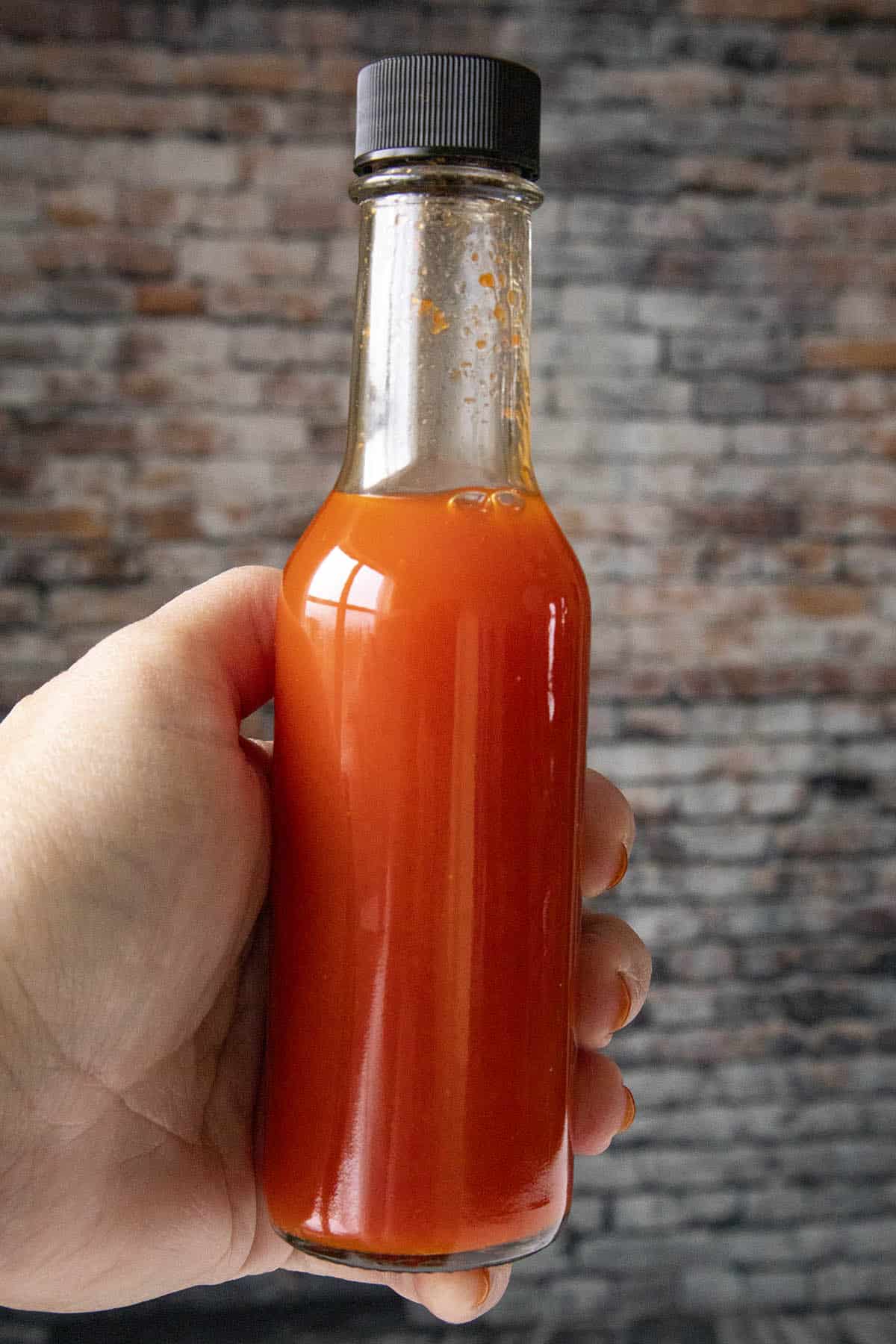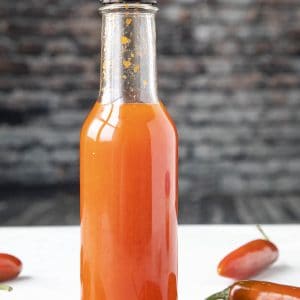Got any questions? Ask away! I’m happy to help. If you enjoy this recipe, I hope you’ll leave a comment with some STARS. Also, please share it on social media. Don’t forget to tag us at #ChiliPepperMadness. I’ll be sure to share! Thanks! — Mike H. The plants were super productive and I am preserving them in so many different ways. Food preservation is important. One of my favorite ways to preserve my peppers is to make hot sauce. I have a LOT of different hot sauce recipes here on the site, all with different styles, ingredients, and types of chili peppers. For this particular hot sauce, I wanted a fermented version, which adds another layer of complexity to the sauce. I grew serrano peppers and waited for them to turn red specifically so I could make this sauce. So many serranos! The plant was very productive. They measure in at 10,000 to 23,000 Scoville Heat Units on the Scoville Scale. For me, that’s a nice level of heat for an every day hot sauce. You don’t have to use serranos, though. This recipe works with any type of chili pepper. This is a very simple hot sauce recipe, though we’re fermenting the peppers first, which may sound complicated, but not at all. The good bacteria is natural Lactic acid bacteria, which consumes carbohydrates in the peppers and converts them to acid. After fermenting, the carbohydrates have been predigested, leaving them with more vitamins and flavor than fresh peppers. Bad bacteria, such as rotting molds, cannot survive in this oxygen-free environment. We create such an environment with salt and brine, which protect the peppers while the good bacteria do their work. The salt is not actually the preservative. It is the acid produced by the fermentation process that does the preserving. There are many benefits to fermented foods, including foods that are more digestible and have more developed flavor. When fermenting peppers, the flavors mellow, and peppers change color a bit, and develop a pleasant smell. Fermentation is one our oldest methods of food preservation. People have preserved foods this way for generations, from wine to cheese to many, many vegetables, including peppers. Let’s talk about how to make a simple fermented hot sauce, shall we? Here is my recipe for fermented hot sauce. Mason jars are good to use as fermentation vessels as well. Make the Brine. Next, mix 1 quart unchlorinated water with 3 tablespoons sea salt. Pour just enough brine over the peppers to cover them, pressing them down a bit as you go. It is important to keep the peppers covered with the salt water brine to avoid spoilage. Check this daily. HELPFUL TIP: A good method to keep the peppers submerged is to fill a baggie with some water, but not all the way. Stuff the baggie into the top of the jar, forcing the peppers down below the brine. Screw on the lid and set the jar away from direct sunlight to ferment for at least 1 week. Ideal temperatures are between 55-75 degrees F. The most active fermentation period is between 1-2 weeks, so be sure to monitor it during this time. “Burp” the jars often by unscrewing the lid a bit to let out some of the accumulating gases. Or, use an airlock or membrane for easier fermenting. See our page, “How to Ferment Peppers”, for more detailed instruction. After 1-2 weeks, the fermenting activity will diminish and the brine will turn cloudy and taste acidic, with a slightly sour flavor. Add the fermented peppers to a food processor or blender, along with 1/2 cup of the brine and 1/2 cup vinegar. You can add more or less of each as desired to your preference. More brine will have more salty flavor, more vinegar will be more acidic. Blend until smooth. OPTIONAL: Add the fermented hot sauce to a pot and bring to a quick boil. Reduce heat and simmer for 15 minutes. This will stop the fermentation process. NOTE: You don’t have to cook the sauce if you don’t want to. Cooking removed the probiotic benefits. It can be used as-is, though you will likely see some continued fermenting activity. If you decide to not cook it, store it in the refrigerator in sealed containers. You may need to burp them to release gas buildup every now and then, though refrigeration will slow the activity. Strain the mixture to remove the solids if desired, or use as-is for a thicker hot sauce. Pour into hot sauce bottles and enjoy. That’s it, my friends! Easy, right? Who knew making a fermented hot sauce could be so simple? It’s really quite a bit like famous Tabasco Hot Sauce, though made with red serrano peppers instead of tabasco peppers. Some people ferment for years. 1 week, however, is enough to get a good ferment. Kahm Yeast. Sometimes you may notice a white film forming on the top of your ferment. It is sour and can form when all of the sugar in your ferment is consumed. It is not a mold, nor is it harmful. It can affect the flavor of your finished hot sauce, so it is best to be scraped away from your ferment. Thicker or Thinner Hot Sauce. If you’re looking for a thicker hot sauce, only use a combined half cup of brine and vinegar, and do not strain the hot sauce. For a thinner hot sauce, add more water and/or vinegar a bit at a time until you achieve the consistency you want. Straining the hot sauce will thin it out considerably. Other Ingredients. This is a very simple Louisiana Style Hot Sauce recipe, using only peppers, vinegar and salt. You can easily include other ingredients to build flavor, such as garlic, onion, herbs and other seasonings. Other Peppers. This method works with any type of chili peppers. Try it with a blend of hot peppers and/or mild peppers.
How long will this sauce keep?
Fermented hot sauce will keep for many months in the refrigerator, or even longer. It’s all about the acidity. To be technical, target level ph for shelf stable foods is below 4.6 ph, but should probably be lower for home cooks, around 3.5 or so, to account for errors. If you’re concerned, add more vinegar to lower the ph. I measured the pH of my finished fermented hot sauce at 3.7, but check with a good pH meter. The best ph meters that I recommend are from Thermoworks. Get yourself a ph meter from Thermoworks today. I am a happy affiliate. Fermented hot sauces that are not cooked at the end with vinegar and/or citrus should be refrigerated. Cooking them stops the fermentation activity and makes them more shelf stable, though they are no longer probiotic. If you like the smaller bottles that most hot sauce makers use, here’s another link: Hot Sauce Bottles, 5 Oz - 24 Pack.
Can I process this hot sauce for longer storage?
Absolutely. Just be sure to use proper canning/jarring safety procedures. Processing the hot sauce in a water bath stops the bacterial activity, making the hot sauce shelf-stable. However, it will no longer be probiotic. The National Center for Home Food Preservation provides home canning instructions and many recipes that have been tested for food safety. NCHFP.uga.edu. Buy Masontop Lids for Fermenting Chili Peppers (and More) I also highly recommend this outstanding book by fermenting experts, Kirsten K. Shockey and Christopher Shockey – “Fiery Ferments: 70 Stimulating Recipes for Hot Sauces, Spicy Chutneys, Kimchis with Kick and Other Blazing Fermented Condiments”. I learned a lot from this book as well as through my own experimentation. Grab a copy today. Good luck, and happy fermenting! Let me know what you make with your pepper mash.
Homemade Sriracha Hot Sauce Fermented Aji-Garlic Hot Sauce Homemade Louisiana Hot Sauce Homemade Tabasco Sauce Spicy Serrano Hot Sauce
Check out more Hot Sauce Recipes or learn more about How to Make Hot Sauce.

